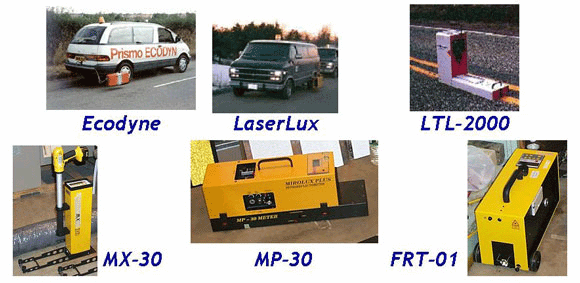Section 4: Portable Retroreflectometers
Anchor: #i999990Introduction
A critical issue associated with the retroreflectivity of pavement markings is the ability to measure retroreflectivity. Most pavement markings are manufactured on-site, and it is not practical to remove a pavement marking so that the retroreflectivity can be measured with a high level of accuracy. Instead, agencies and contractors rely on portable retroreflectometers to measure the retroreflectivity of pavement markings.
Portable pavement marking retroreflectometers have been available for many years. Pavement markings are currently measured according to 30-meter geometry, which represents retroreflectivity at a distance typical of that which drivers view markings. Pavement markings were previously measured at 15-meter geometry, and no simple conversion exists between 15- and 30-meter measurements. Retroreflectometer geometry is described in further detail in ASTM E 1710. Contact TxDOT’s Materials Laboratory for a description of approved retroreflectivity measurement devices. Note that different manufacturers’ retroreflectometers will produce different retroreflectivity values for a given stripe, and no accurate conversion factor exists.
Anchor: #i1000005Handheld vs. Mobile Units
Portable pavement marking retroreflectometers come in two basic types: handheld and mobile. Examples of both types of retroreflectometers are shown in Figure A-2.
Handheld retroreflectometers are much less expensive than mobile units and are much easier to use and require very little training. However, handheld units are inconvenient when a large number of measurements are required or when measuring on roads with high-traffic volumes. There are also safety issues related to the use of handheld units as workers are often exposed to traffic while measuring the retroreflectivity of a marking. Taking handheld measurements often requires lane closures, increasing delay to motorists.
Mobile units on the other hand are much more expensive than handheld units and require a significant amount of maintenance. They also require a highly trained operator to take measurements. However, mobile retroreflectometers produce a very large number of measurements and allow for measurements to be taken at highway speeds without exposure of personnel to traffic or lane closures. Some state transportation agencies own mobile retroreflectometers, although most agencies hire qualified contractors to perform mobile retroreflectivity measurements if the measurements are taken to determine contractor compliance with a performance or warranty specification.
Figure A-2. Examples of Portable Retroreflectometers.
